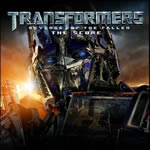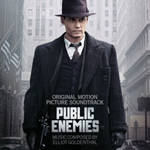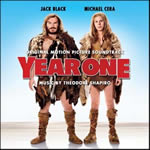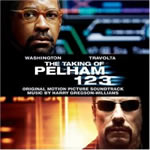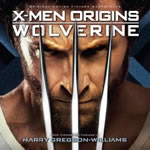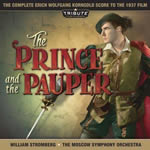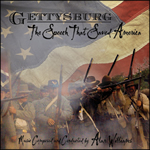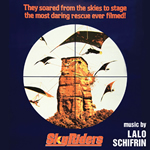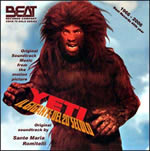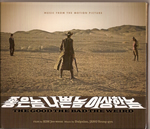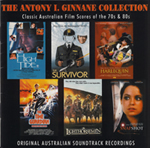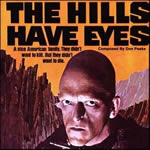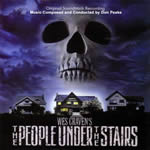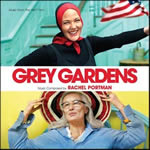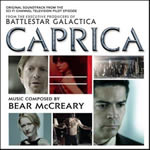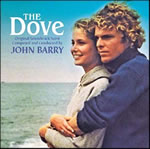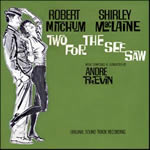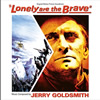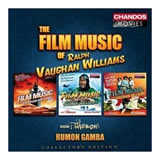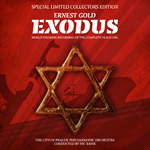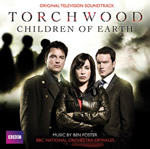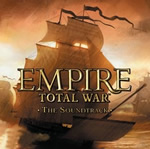 |
Soundtrax: Episode 2009-8
June 29th, 2009By Randall D. Larson
Bruno Coulais Coulais and Coraline
With his recent score for Henry Selick’s 3D-animated adaptation of the Neil Gaiman story, Coraline , French composer Bruno Coulais has provided a striking enchantment for orchestra and choir, which captivatingly brings to life the magical environment and story concocted by the brilliant Gaiman story. Featuring an unusual and perfectly appropriate blending of unusual instruments (mechanical piano, electric bass guitar, jazzy flutes, what sounds like a child’s xylophone, squeaks and squeals and all manner of bells and percussion oddities) with both adult and children’s choirs, and a pervasively eloquent equation of harp liberally spread throughout the length and breadth of the score. The inclusion of a cute if very short song by the band They Might Be Giants fits nicely within the overall sensibility of Coulais’ score. This is a wondrous score, melodically intriguing, instrumentally engaging, and completely intoxicating.
Born in Paris in 1954, Coulais, at the age of 55, has achieved critical acclaim for his film music on both sides of the Atlantic. Classically trained in Paris, he gravitated toward film music through the suggestion of several acquaintances, one of whom, documentary filmmaker François Reichenbach, asked him to compose music to one of his films in 1977. His first foray into feature films came in 1986 with Sébastien Grall’s La Femme Secrète. More than fifty films and television works followed, until his score for the 1996 documentary film, Microcosmos, brought him to international attention. Coulais’ ability to provide music of eloquent grace and beauty for this new breed of artistic documentary with limited narration was further solidified with Winged Migration (2001), Genesis (2004), and The White Planet (2006). At the same time, Coulais has been equally adept in scoring dramatic subjects, such as 2001’s horror-fantasy, Belphégor – Phantom Of The Louvre (2001), Vidocq (2001), and Secret Agents (2004). His nearly 150 film scores to date have covered nearly every genre and embraced all manner of musical styles. Known for his use of ethnic instrumentation and human voice, Coulais is among the new breed of French composers – Alexandre Desplat, Armand Amar, Philippe Rombi among them – providing notably expressive work in contemporary cinema.
I interviewed Coulais last May concerning his score for Coraline.
Q: Your musical style has differed greatly between film scoring projects. Is there such a thing as a “Bruno Coulais” sound in a film score – or do you prefer to attract films that allow you to become as varied as possible?
Bruno Coulais: A kind of schizophrenia exists because sometimes a composer gravitates to the idea of being at the service of the film, and sometimes he inclines to write the most personal music as possible. However some movies allow the composer to be as free as possible in the writing of the music score. I will be of course unable to define my style, but I can tell that I’m mainly attracted by the strangeness, by the hybrid mixing of human voices and instruments, although I also like to work with an homogeneous instrumentation like a string quartet
Q: What would you say is the central element you look for when beginning to score a film? What is it you look for to center your score around in the early stages of a film composition?
Bruno Coulais: At first, I don’t attach myself to the narrative because I think music must be another character of the film. I’m sensitive to the light, to the mood, and to everything that you cannot see directly
Q: What was it, then, that prompted your approach to Coraline? How did you devise its enchanting instrumental design and sonic texture?
Bruno Coulais: While watching the images of Coraline, I was struck by the extraordinary pictorial invention as well as the different stratum of the film, the routine, the fantasy, the epic side, the dark side, the fear, etc., and I thought, agreeing with Henry Selick, that we must use a wide musical range in order to realize all these diversities.
Q: Once you established the musical design of Coraline – how did you develop the score to fit the story as it went along?
Bruno Coulais: Once I wrote the main music themes of the film, I tried to work in a chronological order so I could respect the film’s progress. I must indeed start from a realistic routine mood to go into a fantastic mood, more and more frightening, it was important to make the music evolve with the story. The first themes, like the one illustrating Coraline’s initial visit in the house, seem peaceful, to make the character’s world more realistic. But then, as the bizarreness and the anxiety take over, some funny and absurd bits join the music. But since the beginning, some musical touches make us understand that we’re not in a realistic film.
Q: How did the animation style of the film influence your scoring approach - either compositionally or technically?
Bruno Coulais: Henry Selick’s style is admirable for its complexity, its abundance of details, the humanness of the characters and an extraordinary sense of the atmosphere. To have a musical answer to this variety, I use many musical styles, from the symphonic music to the chamber music going through a music more electronic , through a marching band, a circus music, etc. The difficulty was to make emerge a musical unit in spite of these different stylistic and I believe that the themes have played this part.
Q: How closely did you work with Selick on establishing the musical tone for the music and then spotting the music into the film?
Bruno Coulais: At first, Henry used much of my music as temp music – in particular Le peuple Migrateur (Winged Migration) and Microcosmos. Despite the distance and the language barrier, I have rarely felt so close to a director. Henry explained what he was expecting from the music for each sequence. Once the demo was done, I sent him an mp3 file. He was giving me his first impressions without trying to match the music and the image and then, later on, he gave me his final remarks once the music was cut by Christopher [Murie, editor].
Q: What was most challenging about composing the music for Coraline?
Bruno Coulais: For me, the most challenging thing was to express a secret – since not everything was shown in the picture, but also to find a way for emotion. There are two sequences which, for me, are extremely important. The first sequence is the Mice Marching Band, for which I tried to write a score where musical the density and scale were that of the mice. I used all kind of instruments, like toys, chinese instruments, child brass, child pianos, and also instruments of a traditional Marching Band. The second and the most important is for me the sequence between Coraline and the Other Mother where I intended, in spite of the malevolency of the Other Mother, to bring a certain emotion. I believe Henry Selick, as most of great directors, tried to be sympathetic to the negative characters and I think that he had a certain attachment with the Other Mother.
Special thanks to Daniel Schweiger and Anna Coulais for their assistance in achieving this interview. - rdl
New Soundtrax in Review
Steve Jablonsky transforms anew with a continuation of his 2007 score for Transformers, reprising his eloquent and powerful main theme for the soundtrack for Transformers: Revenge of the Fallen. His theme for Transformers, with its eloquent melodic phrasing, melancholy cadence, and contrast between its slow and lumbering notation and its undercurrent of quickly bowed, clustered strings, remains one my favorite film themes of 2007 (score reviewed in my column for Nov 5, 2007) and its return in the new score is very welcome. Thankfully, Reprise records has issued both a songtrack album and a score album, available on CD and digital download. With 43 minutes of music, the score album is pleasing, especially if you liked the previous Transformers score, as I did. The new score doesn’t break much new ground, with the exception of a track called “Nest” which very effectively fuses Jablonsky’s orchestral score with an instrumental excerpt from a song by Linkin Park that is heard in the film (and appears on the songtrack album). The hybrid track retains the rhythmic drive of the Linkin Park song as well as the eloquent dramatic intensity of Jablonsky’s orchestral scoring and works very well. Much of the rest of the score is in the tried-and-true hybrid, samples-and-synths-and-choir, rhythm-based scoring technique that Jablonsky learned well from his apprenticeship at Media Ventures. It’s effective and likable but perhaps a bit too formulaic. Jablonsky’s spooky music for “The Fallen” consists of an eerie pulse, driven by a low bass beat and entwining, sinewy synth tonalities, which is elsewhere effectively integrated into the larger sound mix as the battles begin. In “The Fallen’s Arrival,” for example, the motif is enhanced and played amongst larger orchestral measures and choir, set off against a huge barrage of horns and timpani that resonate with an extremely powerful clarity, opening up what had been a spooky mysterioso – a threat – into a dissonance that is suddenly and hugely present and dangerous. A blaster beam kind of low twang culminates the track with a cool, low sonority. The score’s high points, apart from the return of his main theme (which is used sparingly on the album), include “Tomb of the Primes,” a despondent but respectful soliloquy for choir and orchestra, remembering lost heroes – the cue itself transforms from melancholy to honorable pride and resonates with a poignant upsurge of the main theme; and “Matrix of Leadership,” a moving choral and strings composition that exemplifies the score’s essential core of dignity, honor, and heroic sacrifice. This score, as did the former one, captures these elements beautifully and this is what I think resonates so well in the score; while the film’s fantasy deals with gigantic mechanical beings who transform from vehicles into bouncing, battling robots – a pretty silly concept at best – Jablonskly brings such a heartfelt honesty and heroic decorum to the music that the viewer, and listener, really believes that “a robot can transform,” to modify another film’s catch phrase, and breathes a strong sensation of life and respectability into the film and its clanking characters.
Decca has released Elliot Goldenthal’s music for the new Michael Mann action-thriller, Public Enemies. Mann directs Johnny Depp, Christian Bale and Marion Cotillard in the story of legendary Depression-era outlaw John Dillinger. This is Goldenthal’s second collaboration with Mann, following their critically acclaimed work on Heat in 1995. Decca’s album intersperses seven score tracks with nine songs by performers such as Billie Holiday, Otis Taylor and Diana Krall – particularly her cover of the classic “Bye, Bye, Blackbird” which makes for uneven listening but a good immersion into the musical atmosphere and songs of the period. Goldenthal’s score is richly tonal, heavy string intonations supported by low brasses and winds conveys a dark mood throughout, both delineating Dillinger as a man while musically conveying his nihilism and his ultimate end. The score maintains this omnipresent gloom throughout, even in the rhythmic and energetic “Plane to Chicago,” where its sense of inevitable doom shadows even the sparkle of the melody and interworking bowing of the strings. But its power lies in the captivating strength of its forward motion, as the score progresses inevitably down the path that Dillinger chose, the music persuasively carries us along that same desolate journey with a sturdy melodic gracefulness.
Theodore Shapiro continues to provide appropriate accompaniment for farcical comedies, playing straight man to Harold Ramis’ Year One as he did with Tropical Thunder and I Love You Man last year. Year One, the low-brow Jack Black/Michael Cera stone age comedy-through-the-ages, afforded Shapiro to address numerous environments and historical era, from the dawn of time to the biblical era, and he accommodates the it all with effectiveness while adapting a fairly contemporary musical style to the various eras depicted in the film; much in the same way that Black and Cera adapt their own comedic personalities into history, essentially playing their 2009 selves despite the mammoth skin and Roman armor. The soundtrack album, produced by Shapiro and released by Lakeshore, is a likable mélange of acoustic rhythms conjoined with modern rock/pop/world beat pulses and beats, and a little contemporary action scoring as well (“Virgin Sacrifice” sounds almost like it could involve Transformers…). The music builds a sturdy environment for which Ramis, Black, and Cera to do their thing, giving it credence and coherency and rendering the landscape over which the story plays a solid believability. From the primitive acoustics of “Main Title” and “Hunters, Gatherers” and the broad, orchestral lines of “Yak Attack” as they merge with more contemporary percussive bop, to the intricate Rózsa-esque poignancy of “The Holy of Holies,” the brusque balls-to-the-wall buffoonery of “The Royal Orgy,” and the triumphal geek heroism of “Zed To The Rescue” with its cheerful electric guitars, strident strings, rumbling drums, and the elegant finish of “The Chosen One,” Shapiro is scoring with broad strokes and the score is a varied but fun mixture.
Harry Gregson-Williams’ score for the new remake of The Taking of Pelham 123 is available on CD and download from Sony. While David Shire’s score for the original 1974 thriller remains a landmark of 70s urban crime scoring (a style replicated somewhat in his brilliant score for 2007’s Zodiac), Gregson-Williams music and its visual accompaniment is pure contemporary/urban action scoring of the kind we’ve heard many times before. Now I like Harry’s music and he’s done some fine scores especially with his Shrek and Narnia music, but he seems to have been shackled either by a temp score or by demands to stay within a very familiar and comfortable routine on Pelham, since its percussive pulsations and hybrid/sampled tonalities have become pretty much score-by-numbers by now. There are a couple of nice moments, like the expressive melody that wafts out of the burbling percussion in “Rigged Contracts” and “All Others Pay Cash,” the poignant piano and strings over wind-rushing synth in “…You A Yankee’s Fan?,” and the climactic, onrushing crescendo of “Manhattan Bridge,” which show Gregson-Williams still at the helm of what he does best (heartfelt melodic passion in the midst of fervent action), but I found much of the rest overly and clearly formulaic.
With X-Men Origins: Wolverine, Gregson-Williams is in somewhat better form and has more or an opportunity to engage his own voice, although here too Harry seems to have been asked to follow a safe and predictable action-movie-music formula. Released by Varese Sarabande, the Wolverine score has its omnipresent de rigueur synth/percussion/orchestra/with occasional electric guitar riffing like Pelham, but it also flexes its orchestral muscles a bit more eloquently. Being an origin story, Harry is able to express a bit more of the character’s psychology than the propulsive speed of Pelham allowed, and the score is thus more cohesive as Gregson-Williams connects the arc of Wolverine’s beginnings as a super-hero. The film, which features “additional music” by Halli Cauthery and Christopher Willis, is an action fest and much of it follows the familiar contemporary action movie patterns, but when he can, Gregson-Williams provides as much expressive musical reflection as is possible. “Kayla” is a splendid example, the motif for the character of Kayla Silverfox, Wolverine’s telepathic love interest. The poignant melody paints her in delicate patterns and hushed orchestration, light strings, piano, harp; the cue’s fragility stands in stark contrast to the muscular percussive throbbing of the ubiquitous action cues. “Adamantium” provides some melodic riffing as we learn about the indestructible metal than is fused with Wolverine’s skeleton to provide him with enhanced mutant power; the cue suggests his growing power with sweeping arcs of growing orchestration as the alloy does its duty. There’s a bit of (sampled?) choir added to the quick-stroked violin riffing of “To The Island,” and then the music takes on a rugged Gothic sonority that is quite refreshing. “The Towers Fall” culminates in a contrapuntal expressive uplifting of melody that is quite compelling; “Memories Lost” opens from a poignant start to a rhythmic, heroic and confident surge of the score’s main theme as Wolverine seems to come into his own, a sensibility explored in splendidly triumphant fashion in the final track, “…I’ll Find My Own Way.” The score is uneven but has some fine moments of eloquence.
The latest film music restoration from Tribute Film Classics is the complete score to the 1937 action film, The Prince and the Pauper by Erich Wolfgang Korngold. Potently performed by the Moscow Symphony, conducted by William Stromberg, the score is richly melodic and superbly orchestrated (following the original 1937 orchestrations of Hugo Freidhofer and Milan Roder), a classic of the Golden Age of swashbuckle and daring do when action scoring meant sweeping melodies, complex harmonic interactions, and rich orchestral depth. The score is made up of rather short cues – in a manner the composer’s son, George Korngold, has described in the notes as more akin to ballet than to opera: “expressing atmosphere and mood – rather than long, thematically complex, densely dramatic music.” The score is therefore a little lighter than more pervasively orchestrated works that preceded (Captain Blood) and followed it (The Adventures of Robin Hood, The Sea Hawk). 41 cues (plus trailer music and an alternative End Title scored for the film’s British release that included a rousing chorus of “God Save The Queen” added to its end) and just about an hour of music comprise the album. The score’s primary theme is the regal motif associated with the prince, replicated in arrangements that are princely (“Main Title,” “Pauper’s Coronation”) personable (“The Prince”), playful (“The Prince Goes Back,” “Street Scene”), and penitent (“Pauper Goes To King”). This is contrasted somewhat by a malicious, staccato motif for the wicked peasant John, whose son Tom bears an uncanny resemblance to the Prince, and when both are grown to young lads they will innocently switch places, to the detriment of all. John is essentially the villain of the piece and his music is offset against the princely main theme which is associated in various permutations with both Tom and the real prince, Edward. John’s Theme is especially wicked in “The Murder, ” enhanced by castanets and downward slices of strings and rustling percussions. Korngold’s arrangement of the main theme in “Mirror,” when the two boys first notice their resemblance and get the idea to switch places, is a marvelous bit of playful interplay. Stromberg puts the Moscow Symphony through its paces on a number of frantically orchestrated action cues, including “Riot,” “Knife Fight,” and “Duel,” which, short as they may be, are just as ferocious and musically solid as the composer’s longer action cues for swashbuckling films of the high seas. This is a masterful reconstruction of a masterful score, splendidly presented. An encyclopedic 32-page booklet with comprehensive notes on the book, the film, the composer, the music, and this restoration, is included.
Alan Williams’ score for the striking History Channel documentary Gettysburg: The Speech That Saved America, is available through the composer’s web site (alanwilliams.com). The 44-minute film examined the impact of Lincoln’s 272-word speech, delivered in November 1863 at the dedication of a national cemetery for the Union soldiers who fell at the battle of Gettysburg, still the nation’s bloodiest battle (later fallen Confederate soldiers were also interred), what it meant at the time and how its poetic words and their meaning have meant to the larger picture of the battle, the dedication, and the cause of freedom for all in our country. Far more than simply honoring the fallen soldiers buried around him in the new cemetery (speaker Edward Everett did that in his two hour oration that preceded the President’s “remarks”), Lincoln chose the occasion to eloquently and perfectly redefine the purpose of the Union in fighting the Civil War (for a quick history lesson, check: http://en.wikipedia.org/wiki/Gettysburg_address ). Williams’ score takes what is really the only direction to go – an honorable and eloquent accompaniment that serves both the documentary narrative showing Lincoln (interestingly performed by an actor but with a computer-generated Lincoln face) in the process of leading the war, grieving over the wounded, and working out the words he will convey in his address) and the action scenes cutting back to the battle and other scenes showing the business of war. A clear-toned and patriotic trumpet melody serves as the score’s primary theme, which recurs in various nuances throughout the score, often supported by field drums. The music poignantly underlies the narration with a subtle power that gave the words the kind of import they needed – both that of the narrator and the Lincoln recitations – and very eloquently serves as its own tribute to the events, the sacrifices, and the poetry of words that those events inspired – and, I believe, continue to inspire.
Aleph Records’ latest archival release of Lalo Schifrin’s film music is for the 1976 action thriller, Sky Riders. A very likable mix of buoyant melody and the kind of jazz-fused tension that Schifrin has excelled at, the Sky Riders score adds the texture of the bouzouki and a few tinges of Greek folk music to fit the film’s setting. Robert Culp and James Coburn star in a story of a hang-gliding rescue of a kidnapped family held for ransom in a fortress like monastery perched high atop a mountain peak in Thessaly. The film’s enthusiastic sequences of gliding through the majestic Greek mountainside clearly evoked expressive music and the score does a good job accentuating the visual splendor as well as the suspense of the kidnapping plot. The score begins with a graceful, carnivalesque waltz called “Flying Circus,” an extended 6:23 track built around an airy circus tune for brass, glockenspiel, and percussion, as it introduces the traveling troupe of virtuoso hang-gliders which Coburn will recruit to his mission. A pair of distinctive suspense cues follow, “Climbers” and “The Riders,” conveyed with quivering bouzouki deftly entwined throughout the passages of strings, winds, and piano. The Greek instrument provides a fresh and effective texture to the suspense material, and becomes a potent a musical conveyor of menace and danger when allied with the pensive string writing and cautionary intonations of brass that Schifrin weaves across his musical canvas. The potent brass figures over dizzyingly swirling strings in “Gliding” and the rolling piano and string interaction in “The Terrorists,” and the apprehensive rhythmic cadence of “The Last Kite,” recall a bit of Schifrin’s Dirty Harry style, until the bouzouki reminds us we’re a far ways from San Francisco; both are extremely interesting and dexterous action cues, marvelously orchestrated and elegantly conveyed even in their most dissonant. The score ends with an exuberant and optimistic finale, cheerful strings playing a motif formerly heard from darker chords of the bouzouki. A fine score nicely salvaged and represented on disc. The package includes an 8-page quad-fold booklet with informative notes by Julie Kirgo about the film, its music, and its place in Schifrin’s impressive filmography.
Beat Records released this a couple of years ago but I’ve just come across it recently and was tremendously impressed. Italian composer Sante Maria Romitelli (Hatchet For The Honeymoon for celebrated director Mario Bava) composed his final film in 1977, Yeti – I Giganti Del 20.Secolo (Yeti – Giant Of The 20th Century). The film, a product of both the late 70s fixation on Yeti/Sasquatch/Bigfoot horror films and the post-1976 King Kong remake binge, tried to outdo all the others by having its yeti be gigantic – an Italian sasquatch of Konglike proportions. The silly film featured a powerful score by Romitelli that incorporated a variety of styles that almost seemed incongruous, which Beat’s soundtrack recording very nicely preserves in fine form. An orchestral main theme for the giant yeti resonates with ominous menace, albeit a little too obviously derived from Orff’s Carmina Burana, but it works effectively in building a strong dramatic drive for the creature. Romitelli’s rhythmic melody as the scientific team melts the ice around the gigantic ape, and later when the freed Yeti wanders around the forest and, ultimately as he flees from gangsters and police in the city, carries a very John Barryesque flavor and paints a very sympathetic portrait of the huge beast, giving these scenes a graceful energy. The score wavers between romantic classicism and pop conventions, with rock/disco instrumentals used during the urban scenes as the businessmen try and exploit the Yeti for commercial purposes, including a celebratory rock version of the main theme performed by a band called The Yetians, heard during the festivities as the giant yeti is brought to Toronto for public display. A luxurious idyllic motif offers an aura of exotic romance as the yeti encounters a young girl and her brother, and a pop/lounge theme featuring a Morriconesque female vocal serves as a contemporary love theme for the Yeti’s feelings for the diminutive heroine, as well as serving as a motif for the dog that accompanies them. Romitelli’s expressive orchestral rhythms and melodies give the film’s sloppy direction, ponderous pacing, and hokey special effects an incongruous appeal.
The Korean Western, The Good The Bad The Weird, has an eclectic but interesting soundtrack provided by composer Jang Young-gyu and a band called Dalpalan. Released on CD in Korea on the CJ Entertainment label, the CD provides a healthy 1hr 12 mins of music in 40 tracks. The music of mix of modern world beat styled pop mixed with elements of Italian Western, Latin and comedic music, and a few other musical idioms. The result is a pretty satisfying mélange of styles that is as entertaining to hear as the film was to watch. The film is a richly visualized Western that takes place in 1940s Manchuria (but its style is clearly the American wild west) about a trio of bandits seeking a hidden treasure of gold, while avoiding both the occupying Japanese army and nomadic Chinese tribes, which are also seeking the gold. While not as flagrantly genre-bending as Miike’s SPAGHETTI WESTERN DJANGO, the film is very clearly in the style, scope, and fashion of THE GOOD, THE BAD & THE UGLY and its ilk. The wildly diversified soundtrack embraces all manner of styles, from primitive vocalisms (tracks 8, 16, 23) to poignant or very energetically rhythmic flamenco guitar passages (tracks 17, 29, respectively), Italian Western styled whistling (track 19) to moments of symphonic/operatic chorale splendor (track 26), Latino dance music (Tracks 2, 4) to lightly percussive rhythmic riffs (tracks 14, 15, 21), and tracks that seem almost like a warped fusion of traditional Japanese folk music with cartoon or carnival tunes (tracks 12, 14). It’s not a particularly thematic score as it is a collection of fairly unrelated musical bits (average length is about 1 to 1.5 minutes) that, if anything, have a kind of percussive rhythm in common. An electric guitar piece recurs a couple of times at beginning and end (tracks 7, 11, 25, 29; track 31, “Winner Takes All,” being its most expansive variation). But it’s a fun score and was enjoyable in its parts as in its whole. A lengthy action scene is accompanied by the instrumental portion of Santa Esmeralda’s Latin pop interpretation of “Don’t Let Me Be Misunderstood” (also used in KILL BILL; its style in many ways defines the overall scope and sensibility of this score), which is included on the CD, as are eight “bonus tracks” of essentially expanded variations on various score tracks (a whistled of the main theme, presented on track 39, is especially appealing). The manic mood of most of the music, in its rampant diversity and its exuberant syncretistic energy, captured the film’s own sense of comedic/hyperdramatic intensity.
Australia’s 1M1 records (www.1m1.com.au ) has released Australian Film Themes Vol. 2: The Anthony l. Ginnane Collection, a collection of themes and suites from 14 films produced by Ginnane between 1976 and 1988. In those 13 years Ginnane made some of the most famous Australian films of that era as the film industry down under was making an international name for itself. The music ranges from the classical romanticism of The Lighthorsemen to the blind terror of Incident at Raven's Gate; from the simple beauty of High Tide to the chilling choirs of Thirst and The Everlasting Secret Family; from the suspense of Snapshot to the futuristic sounds of The Time Guardian. Five of the cues presented here have never been issues before. This is a marvelous collection of significant film music, and more than a simple “movie themes” collection. 1M1’s Philip Powers has compiled extensive suites, ranging from 2 minutes to nearly 9 minutes in length, allowing the essence of these film scores to shine. Mario Millo’s marvelous symphonic music from The Lighthorsemen, for example, is a brilliantly expressive and melodic adventure score, one of the best Australian scores of the 1980s (and winner of an AFI Award for Best Music), and is presented in a terrific 8:57 min. suite. Six of the tracks are by Brian May, who was Ginnane’s first choice for composer during the late 70s and early 80s; May’s music for the films Harlequin, Patrick, Thirst, The Survivor, Race For The Yankee Zephyr, and Snapshot ranges from eloquently lyrical to spooky/scary (most of these are fantasy/horror films). In contrast, Peter Best’s score for 1987’s contemporary thriller High Tide is contemporary sax and guitars, very sultry and alluring; Tony Bremner’s music for The Everlasting Secret Family (1988) is exquisitely delicate chamber music, and Chris Neal’s Grievous Bodily Harm (1988) is atmospherically piercing electronica. Allan Zavod’s broad fantasy score for 1987’s The Time Guardian, presented at 7:13 mins, is brooding synth action interspersed by melodic reflective passages. Graham Tardif’s AFI Award-nominated Incident At Raven’s Gate (1988) is a compelling synth and piano composition, fast paced and dramatically intense, while Frank Strangio’s music for The Dreaming (also 1988) is a pervasive blast of oppressive chords of sampled orchestra, keyboard, and drums. The album includes a healthy booklet with full page data on each film and notes by both Ginnane and album producer Philip Powers. Definitely a must have for any serious overview of Australian film music.
Hitchcock Media has released an extensive soundtrack of the music of Don Peake (Knight Rider) from Wes Craven’s original 1977 mutant cannibal shocker, The Hills Have Eyes. Peake’s score enhanced Craven’s disturbing premise with a mixture of rhythmic rock riffs that open the film, as the group of travelers journeys from the comfort of their travels and their cars and becomes lost in the nightmare of cannibal territory, and all manner of acoustic and synth atonal sound design, giving the soundtrack a claustrophobic and nightmarish quality that kept viewers constantly on edge as the characters are stalked and assaulted by the inbreed mountain cannibals. It’s a difficult listen on CD, 41 tracks of between 20 seconds and almost 3 minutes each, but the approach here was to build a nightmarish musical sound design to intensity the film’s fright factor, and Peake did a tremendous job. The recording is an interesting contrast, thirty years away from what we have today, yet Peake crafted a compelling sonic ambiance, punctuated with all manner of stingers and oscillated tonalities and mutated musical things to jolt viewer and listener alike. Track 18 stirs the pot again with a Knight Rider-like rhythmic chase riff, a motif that is reprised amidst the mysterioso of Track 28. Tracks 24 and 25 are especially compelling scares, as they become more tonal and rhythmic, entwined around snares of guitar and synth, punctuated by piano, drums, and spark sounds, and generate a notable amount of tension. Track 26 adopts a Carpenteresque dark, chordal synth tone embellished by pizzicato strings and guitar, very spooky. Much of the score is atonal fusion and experimental sound design that may have limited appeal, but Peake’s inventive instrumentation provides an array of unusually interoperative sounds. Incidentally, the M-number count offs have been left on the front of each track, which are presented in recording session sequence, not film sequence, in order to preserve the authenticity of the sessions; in view of the style of the music, this works fine and shouldn’t be much of a distraction.
Hitchcock Media has also reissued Peake’s music for Wes Craven’s The People Under The Stairs (1991). Initially released as a 25-minute suite by Bay Cities and on Milan in France, paired with Graeme Revell’s original (rejected) score for the film, Hitchcock offers the score in cue form, with 37 tracks including three of Peake’s demo tracks as submitted to Craven when he started the score. The score is thoroughly tonal: long, sustained, sinewy, reverbed lines of orchestra and synth establish a very spooky atmospheric tonality or mirrored, reflecting echoes of synth, punctuated by tracks of severely shrill atonal dissonance (Tracks 7, 10) or rhythmic, panic-inducing chase and pursuit cues (Tracks 12, 21; demo in Track 3). Track 19 is a very interesting ambiance for low piano strokes over a sustained, wind-rustling synth tonality. A sparkling environment of bell tree and high end xylophone inhabit Track 20, establishing a delicate spookiness. The tracks are fairly short, building a progressively disturbing sonic atmosphere in small bites, giving Craven’s music a very potent and pervasive sense of frightening apprehension, build-up, and pay off.
Alfons Conde, who wrote the scores for The Abandoned and The Dark Hour, is back with a new large orchestral horror score for Spanish director Elio Quiroga (The Dark Hour). No-Do, which is marketed under the titleThe Beckoning in the US, is a ghost thriller about a new mother obsessing over her new baby after moving to what turns out to be a haunted house. Released by MovieScore Media, Conde’s orchestra is augmented by choir and solo vocalists, often singing in low, slow sonorities, adding a haunting enhancement to the orchestral atmospheres. No-Do is a delicate and deliciously tonal composition; the film is about obsession and post-partum haunting, and Conde assumes a sensitive grace when approaching the subject, with soft atmospheres and wispy sonorities, like the fresh skin of a gray-dappled newborn or the frightful gaze of a new mother who thinks she may have seen something out of the corner of her eye. “Who’s Knocking on the Door” and “Footprints on the Wall” both derive especially potent spookiness with their progressively sustained and growing measures; the low choral chanting in “Francesca Meets Miguel” is both menacing and reassuring in its sensibility. “Because I’m Telling You” features a sublime and empathetic piano melody. While most of the tracks are fairly short, the score culminates in a massive 13-minute finale, “The Martyrs and the Third Postulate,” a tremendously progressive mix of orchestra and choir developing into a stunning progression of choir and symphonics, an amazing slow crescendo of elegant and alluring power; after its crescendo a quiet coda of hushed female voice, chorus, and intricate melodic phrasing brings the score to a quiet and haunting conclusion. This is the type of sustained composition that horror films rarely afford, and Conde simply provides an astonishingly conclusion of operatic immensity and import. The score has some traditional spooky moments, as in the choral glissando that stings the middle of “The Three Girls,” and some other familiar tonalities, but for the most part Conde, with his treatment of choral and symphonics, has crafted an effective and likable ghost movie score, made all the more impressive by its epic conclusion.
Rachel Portman has provided a delightful score for Grey Gardens, a complicated HBO cable-TV drama based on the life stories of the eccentric aunt and first cousin of Jackie Onassis (both named Edith) and their tenuous grip on reality during their seclusion on their titular Long Island estate. Portman, whose gift for heartfelt melodic expression has been well served in films like The Legend of Bagger Vance and The Duchess, has provided a captivating orchestral score, released on CD by Varese Sarabande. This film is based neither on the 1975 documentary film nor the Broadway musical version of the Ediths’ lives, but takes a rather staunch and optimistic approach in portraying their characters, focusing more on their glory days as socialites despite the dilapidation and eccentricity of their declining years. Portman, too, paints a sympathetic and vividly optimistic portrait of both Ediths, a portrait depicted from the inside out – their perspective and their interpretation of events and situations. The score’s mood darkens only when Portman accompanies the Health Department raid that brought public awareness to the Ediths’ living conditions, but the socialite’s strident cheer is soon regained. This perspective provides opportunities for an assortment of enchanting melodies, tender interludes, and expressive gaiety as the Ediths enjoy themselves in their safe solitude. As the film explores their lives, their “extraordinary determination,” the outward façade that belied or perhaps enabled their seemingly unawareness of the squalor of their living conditions, Portman continues to focus on the façade, the orchid growing amidst the detritus of the forest floor, and like that orchid, it’s a thing of captivating and focused beauty.
Caprica, the Sci-Fi Channel’s new prequel series to Battlestar Galactica, takes place on the planet Caprica in the early days of the creation of BG’s Cylons. It’s more of a domestic drama that happens to take place in the future on a different planet, while setting the stage for events that will eventually transpire to bring out the inevitable future of Battlestar Galactica. BG’s Bear McCreary score for the pilot episode, released on CD by La-La Land Records, is a far cry from his ethnic-centric approach to Battlestar Galactica. Recognizing that this is a different, earlier, and far more familiar society, McCreary provides a simpler and more direct musical approach primarily from a modern chamber orchestra. The focus is on two families whose association and conflict are central to the show’s storyline, the Graystones and the Adamas; but the approach is straightforward, with little association with the fact that we’re in the future, on another planet, or that the Graystone daughter is a computer representation of the girl before she died. “Zoe’s Avatar” resonates with graceful beauty and life, even though the cue is associated with a computer program, but one that houses the essence of the Graystone daughter. The score provides a pleasing and sympathetically layered melodic tonality, intimate and reflective, while occasionally nodding to the world that is to come. More dramatic cues, like the rhythmic pulses that grow into the unavoidable climax of “”Terrorism On The Lev,” or the subtly powerful orchestral resolution of “The Adama Name,” hint a little more explicitly at the musical texture of the far ahead world of Battlestar; McCreary brings in the ethnic instruments and taiko drums for “Cybernetic Life Form Node,” (=Cylon), which in the creation of the first cylon is the show’s clearest reference to the events that will occur in this show’s coming future. McCreary’s task in scoring Caprica is kind of akin to what John Williams had to do when scoring Star Wars Episodes 1-3: focus on the world and the characters where they are now, while anticipating and subtly forecasting ahead to what everyone knows will occur to them in Episodes 4-6. McCreary accomplishes that deftly with a score that is both extremely serviceable to the drama and action of Caprica while fitting perfectly into the growing mythology arc that will eventually join both series seamlessly together.
UK label Harkit has released the breezy John Barry adventure score to The Dove, Charles Jarrot’s 1974 film telling the true story of a 16 year old who sailed alone around the world in a 23 foot sloop named “The Dove.” Barry’s score, composed between the oppressive dramatic nuances of The Glass Menagerie and The Tamarind Seed and the wild, brassy action of The Man With The Golden Gun, is one of his lightest and most captivating scores of the decade, featuring a pair of splendid melodic themes – the main theme and a love theme, “Sail the Summer Winds,” which is also presented as a song, sung by former New Seeker’s vocalist Lyn Paul, with lyrics by frequent Barry collaborator Don Black. The themes, and subordinate melodies, are delightful and the score, previously issued only on LP, is every bit a winner. Harkit, as usual, includes thorough liner notes, by Darren Allison, in a well-illustrated accompanying booklet.
In a limited edition of 1000 copies, already sold out at the label’s web site, Kritzerland has released Andre Previn’s score for Robert Wise’s 1962 romantic drama, Two For The Seesaw. As Bruce Kimmel mentions in his liner notes for the album, 1962 was a banner year for classic films – and classic film music (kind of the Silver Age equivalent to 1939, I would suggest), and one of them is certainly this marvelous score and its accompanying picture. Robert Mitchum and Shirley MacLaine star as unlikely lovers who meet in New York in a story that would eventually become the Broadway musical Seesaw. Previn’s score is contemporary jazz-based, and romantically flavored, and Kritzerland’s album replicates and preserves the original United Artists soundtrack LP issued in 1962, and out of print almost since. Remastered from the original master tapes, found in remarkably good condition, the CD sounds just fine, and Previn’s music, whether it’s the sultry and provocative main theme or it’s the catchy jazz tunes like “He Saw She Saw” or “Saltie Sophie,” is quite intoxicating.
Film Scoring NewsThe 35th Annual Saturn Awards, presented on June 24th by the Academy of Science Fiction, Fantasy and Horror Films, have awarded Hans Zimmer and James Newton Howard the Best Music award for their work on The Dark Knight. Other nominees were Alexandre Desplat for The Curious Case Of Benjamin Button, Ramin Djawadi for Iron Man, Clint Eastwood for Changeling, John Ottman for Valkyrie [not sci-fi but qualified as a thriller] , and John Powell for Jumper.
www.saturnawards.org/In addition to his Saturn Award nomination for best score for the action thriller Valkyrie, film editor and composer John Ottman will be honored this Saturday as the Composer/Editor Of Vision at the 36th Annual Vision Awards. The Vision Awards honor pioneering visionaries in Film, TV, Music, Research, Technology and Leadership. Ottman is currently scoring Astro Boy, the animated, sci-fi/action film starring Nicolas Cage and Kristen Bell. Last year Ottman reteamed with director Bryan Singer as the editor and composer for Valkyrie, after having edited and scored nearly all of Singer's films, including The Usual Suspects, Apt Pupil and Superman Returns.
Soundtrack News
Varese Sarabande has announced their limited edition June CD Club titles: Jerry Goldsmith’s very first feature score, 1962s Lonely Are The Brave, Bill Conti’s Oscar-winning but never released original soundtrack to The Right Stuff (3000 copies), David Shire’s Norma Rae (1500 copies), and Alex North’s Hard Contract (1000 copies).
Among this week’s soundtrack releases are Intrada’s premiere release of James Horner’s score to The Journey of Natty Gann (replacing a rejected Elmer Bernstein score), Varese Sarabande’s Land of the Lost (Michael Giacchino), Ice Age: Dawn of the Dinosaurs (John Powell), and My Sister’s Keeper (Aaron Zigman), BSX Records’ Brothers At War (Lee Holdridge) and You Must Remember This Too: Classic Film Music Arranged For Guitar, Kritzerland’s God’s Little Acre (Elmer Bernstein), Reprise Record’s Transformers: Revenge of the Fallen (Steve Jablonsky), Prometheus’ 2-CD archival release of Bernard Herrmann’s The 7th Voyage of Sinbad, and FSM’s None But The Brave (1965 John Williams war film).
Film Score Monthly has announced its next Silver Age release as Quincy Jones’ score from The Split, a 1968 caper film based on the Richard Stark novel in which Jim Brown leads a ragtag group of underworld thugs (including Ernest Borgnine, Jack Klugman, Warren Oates and Donald Sutherland) in a robbery of the L.A. Coliseum during an NFL game. Gene Hackman appears late in the film in a pivotal role as a detective. FSM’s premiere CD of the complete score to The Split is mastered from the original ½” three-track stereo masters for excellent sound quality. Liner notes by Scott Bettencourt and Alexander Kaplan give a thorough background on the literary world of Richard Stark (a pseudonym for Donald E. Westlake) and this film adaptation.
Chandos has repackaged their three-volume Film Music of Ralph Vaughan-Williams releases in a handy 3-CD box set. The complete booklets from each of the three previously-released volumes are included in the box, with the CDs housed in paper sleeves inside a sturdy cardboard box. The music is nicely performed by the BBC Philharmonic, enhanced by several choral groups, conducted by Ramon Gamba. Lengthy and strenuous suites from Scott of the Antarctic, 49th Parallel, Coastal Command, The Loves of Joanna Godden and others and well presented.
Tadlow Music has announced that their next newly recorded classic film scores will be Richard Rodney Bennett’s Far From The Madding Crowd, which will also include works from a number of other film and classical composers including Ralph Vaughan Williams, William Walton, Rachel Portman, Patrick Doyle, and Dario Marianelli; and Ernest Gold’s Exodus, presented in a world premiere complete film score recording, performed by the City of Prague Orchestra conducted by Nic Raine. In addition to 25 tracks from Exodus, the 2-CD set will include additional selections by Gold (It’s a Mad, Mad, Mad, Mad World and Ship of Fools) and music from other historical political thrillers, Sol Kaplan’s Judith, Jerry Goldsmith’s QB VII, John Williams’ Schindler’s List, and Elmer Bernstein’s Cast A Giant Shadow. Release date is set for Sept. 9th.
www.tadlowmusic.comNaxos has released Great Movie Themes 2, a collection of fourteen tracks from recent films performed by the Royal Liverpool Philharmonic Orchestra, conducted by film composer Carl Davis. The content runs the gamut from perennial theme-collection faves like Francis Lai’s Love Story, Henry Mancini’s The Pink Panther, Nino Rota’s Romeo and Juliet and The Godfather, Myer’s The Deerhunter, and John Williams’ Superman and Jurassic Park as well as Badelt’s Pirates of the Caribbean, Elfman’s Batman, Yared’s The English Patient and Davis’ own The French Lieutenant’s Woman. It’s pretty standard stuff, but is nicely presented in full digital sound under a very capable conductor, and makes for a nice compilation of notable film music. A notable set of notes by John Riley accompanies the music in a tri-fold booklet, placing the films and the music in historical context.
Perseverance Records has announced on Facebook and My Space that they will release a special limited edition promotions score of Craig Safan’s score for the 1980's slasher thriller, Fade to Black. The label will be producing 500 copies only. In addition, the label has signed the contract with MGM to produce and release a complete version of J. Peter Robinson's chilling score to John Schlesinger's thriller The Believers. This release will be limited to 1000 copies.
Universal France will release Michel Legrand’s score to The Three Musketeers coupled with his rejected (and previously unreleased) score to Robin and Miriam in late July.
The next CD from Kritzerland will be the first ever soundtrack release of the 1973 film Cops And Robbers, which starred Cliff Gorman and Joseph Bologna as two cops who plan a heist. It was written by Donald E. Westlake, whose novel The Hot Rock had helped make him the top name in comedy capers, and the original score, used in the final film largely as source music, was composed by Michel Legrand. Kritzerland's disc, limited to 1000 units and expected to be released in August, presents the Legrand cues from a planned but never released soundtrack LP. – via fsm
MovieScore Media has signed the deal for a July CD release of Bill Brown's score for the 2009 Cuba Gooding Jr. horror thriller The Devil's Tomb.
In celebration of its 20th year, Australia’s 1M1 Records has reissued its first release from 1989. Music For Pianos, Percussion and Synthesizers allowed five Australian film composers to write music especially for this CD, without the constraints of visuals. Simon Walker (For The Term of His Natural Life, The Wild Duck), Chris Neal (Buddies – Getting Even, Bodyline), Guy Gross (Farscape, Adventures of Priscilla Queen of the Desert), Philip Powers (Ironbark Bill, Waiting for the Big Bang), and Mark Isaacs (Wind in the Willows, Robin Hood) have provided five original compositions for this collection.
www.1m1.com.au/detail.asp?p=394
In anticipation of the latest installment of the BBC’s cult series Torchwood, Silva Screen records is set to release the soundtrack album on July 27th. The soundtrack to Torchwood - Children Of Earth features music highlights from Torchwood series 3, the spin-off series from Doctor Who writer Russell T. Davies. It features the highly emotive, adrenalin-fuelled contemporary score composed by Ben Foster, best-known for his work as orchestrator and conductor on Doctor Who and now as composer for Torchwood, which earned him two nominations for best soundtrack at the BAFTA Cymru Awards. Ben started his Film & TV career with scoring over 30 short films for various European directors and subsequently writing for a variety of television programs. Most recently he has worked on big budget films The Mummy 3 - Tomb of the Dragon Emperor, Glorious 39, Is Anybody There? and Hoodwinked 2. In May 2009 he conducted the London Soundtrack Orchestra in the first complete performance of Herrmann’s score to Psycho live with the film.
Silva Screen has also issued two new compilations as digital releases, Music From the Films of Paul Newman (featuring tracks from some of Newman’s best films, including Butch Cassidy And The Sundance Kid, The Sting, The Silver Chalice, Exodus, The Towering Inferno, and Road to Perdition) and Music From the Films of Johnny Depp (including music from the Pirates Of The Caribbean trilogy, Sweeney Todd, Edward Scissorhands and A Nightmare On Elm Street). Silva also has released in the UK soundtrack albums to the new release, Mutant Chronicles, composed by Richard Wells. www.silvascreenmusic.com
MovieScoreMedia has released the score by Stuart Hancock (Underground) score for Chee Keong Cheung's new film, Bodyguard - A New Beginning – an equally engaging modern film music piece written for orchestra and electronics. This score puts a little more emphasis on character-driven music, as the story is about a Hong Kong bodyguard who is sent to the UK to protect a woman whose identity is known only by his boss. Hancock's dark, percussive and driving action music is coupled with reflective themes and atmospheric suspense writing. MSM’s release of the score coincides with the DVD release of the film in the UK. The label has also released as a digital download the music to Laid To Rest, a new independent horror film from director Robert Hall, who decided to create an experimental avant garde soundtrack performed by his own metal band, Deadbox (Hall, Thomas Dekker, Jason M. Hall, and Andrew Bentler). Laid to Rest “features an aggressive and unsettling original score which avoids the usual genre cliches: instead of a stinger-filled low budget score featuring the usual abundance of sampled string effects and pre-fabricated orchestral stabs, [Hall provides] an unusual horror score which is effective and horrific, but also a lot of fun.” Finally, MSM also has released the hard-hitting contemporary score by Ben Mink from Fifty Dead Men Walking as a digital online release. Starring Ben Kingsley, Jim Sturgess, Kevin Zegers, Natalie Press and Rose McGowan, the film is a gritty action thriller based on the true story by Martin McGartland who was recruited by the British Police to spy on the IRA in the late eighties. The film is directed by Kari Skogland (Liberty Stands Still, White Lies) and “in sync with her cinematic vision is Ben Mink's percussive and intense electronic score, featuring a lot of guitar and electric violin solos.”
Games Music News
This week, Sumthing Else Music Works, Inc., is releasing Empire: Total War™ - The Soundtrack featuring the musical score from the latest installment of The Creative Assembly's multi award winning Total War™ PC gaming franchise. The Soundtrack album features the epic orchestral score composed by Richard Beddow (Viking: Battle For Asgard), Richard Birdsall, Walter Nair, Simon Ravn and performed by The Slovak National Symphony Orchestra at the Slovak Radio Concert Hall in Bratislava. The score was orchestrated and conducted by Nic Raine and the soundtrack was produced by lead composer Richard Beddow.
“Undertaking the challenge of the music production for Empire: Total War was no simple task,” said Beddow. “The game needed music to convey its size and breadth, covering the various countries at war, delicately accompanying campaign gameplay and underpinning the various cinematics and events in the game.”
Empire: Total War is set in the 18th century, a turbulent period alive with global conflict, revolutionary fervor and technological advances. With themes such as the Industrial Revolution, America's struggle for independence, the race to control Eastern trade routes and the globalization of war on land and sea, Empire: Total War is said to deliver an incredibly rich and dynamic PC RTS game experience. For more information on the game, please visit www.totalwar.com.
Also announced by Sumthing Else Music is the original game score to Banjo-Kazooie™: Nuts & Bolts, the third installment of the Banjo-Kazooie series developed by Rare Ltd. The soundtrack album features original musical compositions by Robin Beanland (Killer Instinct, Conker's Bad Fur Day), Grant Kirkhope (Banjo-Kazooie, Banjo-Tooie) and David Clynick (Perfect Dark, Perfect Dark Zero).
For more information on Sumthing Else Music Works and its complete catalog of video game soundtracks, please visit www.sumthing.com and www.sumthingdigital.com.
Randall Larson was for many years senior editor for Soundtrack Magazine, publisher of CinemaScore: The Film Music Journal, and a film music columnist for Cinefantastique magazine. A specialist on horror film music, he is the author of Musique Fantastique: A Survey of Film Music from the Fantastic Cinema and Music From the House of Hammer. He now reviews soundtracks for Music from the Movies, Cemetery Dance magazine, and writes for Film Music Magazine and others. For more information, see: www.myspace.com/larsonrdl
Randall can be contacted at soundtraxrdl@aol.com


.jpg)
